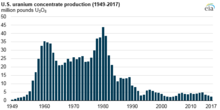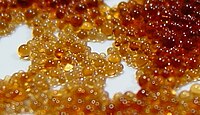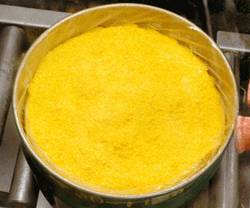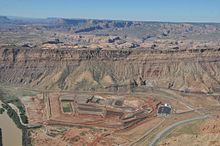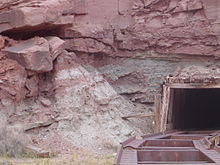Uranium mining in the United States
[22] A total of 1.3 million pounds of U3O8 at a grade of 0.76% was produced from open pit and underground operations, with milling taking place in Washington and Utah.
The uranium is contained in the phosphate minerals francolite, crandallite, millisite, wavellite, and vivianite, found in Miocene and Pliocene sediments of the Bone Valley Formation.
[29] Recovery process costs are estimated at $22 to $54 per pound of U3O8; higher than the market price of uranium during the 25-year period spanning the 1980s through the early first decade of the 21st century.
Discovered in September 1953, it was first mined as a silver deposit and produced 45 metric tons of U3O8 (80% of Nevada's historical production) from 1954 until 1966, from a small open pit and from underground.
[38][39] Uranium occurs as the secondary minerals autunite and meta-autunite after uraninite and coffinite in fractured Cambrian metamorphosed shales and quartzite, at or near the contact with Jurassic porphyritic quartz monzonite.
Uranium in New Mexico is almost all in the Grants mineral belt, along the south margin of the San Juan Basin in McKinley and Cibola counties, in the northwest part of the state.
[54][55] The uranium mineral autunite was reported in 1874 near the town of Mauch Chunk (present-day Jim Thorpe) in Carbon County, eastern Pennsylvania.
The uranium at the Mount Pisgah deposit is primarily in an unidentified black mineral in pods and rolls in the basal conglomerate of the Mauch Chunk Formation (Mississippian).
The core drilling test mining occurred in 1953 at the Mauch Chunk Ridge deposit but has seen no further development due to the low uranium content in the rock of about .011 to .013%.
The uranium occurs in Cretaceous sandstones of the Inyan Kara group, where it outcrops along the southern edge of the Black Hills in Fall River County, South Dakota.
[60] High winds blew the reconnaissance flight off their planned survey route over the Slim Buttes twenty miles southeast of the North Cave Hills.
[62] In January 2007[63] Powertech Uranium Corporation received a state permit to drill boreholes to evaluate its Dewey-Burdock project, in Custer and Fall River counties northwest of Edgemont.
[65] By 2019 Powertech (now a subsidiary of enCore Energy Corp)[66] had increased the measured and indicated resource to 17.1 million pounds of uranium oxide and plans to bring the property into production as an in-situ leaching mine.
Union Carbide was the joint venture partner on the project with Marline until early 1984 when it dropped its option on the property due to declining uranium prices.
The National Research Council study, funded indirectly by a $1.4 million grant from Virginia Uranium to the Commonwealth, resulted in a report released in December 2011.
The report found that although there are internationally accepted best practices to mitigate some risks, Virginia faces "steep hurdles" if it is to undertake uranium mining and processing within a regulatory setting that appropriately protects workers, the public, and the environment.
In addition, if uranium mining, processing, and reclamation were designed, constructed, operated, and monitored according to best practices, near-to-moderate-term environmental effects should be substantially reduced, the report found.
[99] However, the report noted that Virginia's high water table and heavy rainfall differed from other parts of the United States—typically dry, Western states—where uranium mining has taken place.
While it is likely that tailings impoundment sites would be safe for at least 200 years if designed and built according to modern best practices, the long-term risks of radioactive contaminant release are unknown.
The ore occurs as disseminations, replacements, and stockworks in Precambrian metamorphic rocks of the Togo formation, in a roof pendant in Cretaceous porphyritic quartz monzonite.
[104] Western Nuclear discovered the Spokane Mountain uranium deposit in 1975, two miles (3.2 km) northeast of the Midnite Mine, and in a similar geologic setting.
By 2020, the only active uranium mine in Wyoming was the Smith Ranch-Highland in-situ leaching operation in the Powder River Basin, owned by Cameco.
Between 1966 and 1971, thousands of homes and commercial buildings in the Colorado Plateau region were "found to contain anomalously high concentrations of radon, after being built on uranium tailings taken from piles under the authority of the Atomic Energy Commission".
This would cause more sudden forms of radiation exposure, but the contamination of land and water sources would happen slowly over time and leech into Navajo households.
Epidemiologic studies of the families of these workers have shown increased incidents of radiation-induced cancers, miscarriages, cleft palates and other birth defects.
Native tribes have already started a push to shut down new mining operation plans and are highlighting the need for approval of those in the community unlike previous instances where the current system of colonialism has been the primary way of thinking.
Disregarding the known health risks imposed by exposure to uranium, the private companies and the United States Atomic Energy Commission failed to inform the Navajo workers about the dangers and to regulate the mining to minimize contamination.
[19] Lands that have been subject to permanent environmental damages for the collective good are referred to as “national sacrifice zones.” These zones have been commonly caused by polluting industries such as uranium mining sites and United States Military bases.
Polluting industries like these leave hazardous chemicals in their wake for the surrounding residents and threaten the economics, cultures and welfare of the tribes living in or near these sacrifice zones.
The people that live on these wastelands are subject to disproportionate amounts of exposure to environmental harms, like groundwater contamination and the effects from PCBs being in their system.

